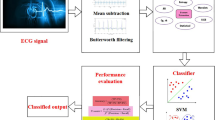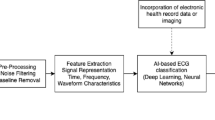Abstract
Purpose
Conventional therapies for obstructive sleep apnea (OSA) are effective but suffer from poor patient adherence and may not fully alleviate major OSA-associated cardiovascular risk factors or improve certain aspects of quality of life. Predicting the onset of disordered breathing events in OSA patients may lead to improved strategies for treating OSA and inform our understanding of underlying disease mechanisms. In this work, we describe a deployable system capable of performing real-time predictions of sleep disordered breathing events in patients diagnosed with OSA, providing a novel approach for gaining insight into OSA pathophysiology, discovering population subgroups, and improving therapies.
Methods
LArge Memory STorage and Retrieval artificial neural networks with 864 different configurations were applied to polysomnogram records from 64 patients. Wavelet transforms, measures of entropy, and other statistics were applied to six physiological signals to provide network inputs. Approximate statistical tests were used to determine the best performing network for each patient. The most important predictors of disordered breathing events in OSA patients were determined by analyzing internal network parameters.
Results
The average optimized individual prediction sensitivity and specificity were 0.81 and 0.77, respectively. Predictions were better than random guessing for all OSA patients. Analysis of internal network parameters revealed a high degree of heterogeneity among disordered breathing event predictors and may reveal patient subgroups.
Conclusions
We report the first practical system to predict individual disordered breathing events in a heterogeneous group of patients diagnosed with OSA. The pattern of disordered breathing predictors suggests variable underlying pathophysiological mechanisms and highlights the need for an individualized approach to OSA diagnosis, therapy, and management.




Similar content being viewed by others
References
Peppard PE, Young T, Barnet JH et al (2013) Increased prevalence of sleep-disordered breathing in adults. Am J Epidemiol. doi:10.1093/aje/kws342
Morrell MJ, Jackson ML, Twigg GL et al (2010) Changes in brain morphology in patients with obstructive sleep apnoea. Thorax 65:908–914. doi:10.1136/thx.2009.126730
Mulgrew AT, Ryan CF, Fleetham JA et al (2007) The impact of obstructive sleep apnea and daytime sleepiness on work limitation. Sleep Med 9:42–53. doi:10.1016/j.sleep.2007.01.009
Omachi TA, Claman DM, Blanc PD, Eisner MD (2009) Obstructive sleep apnea: a risk factor for work disability. Sleep 32:791–798
Tregear S, Reston J, Schoelles K, Phillips B (2009) Obstructive sleep apnea and risk of motor vehicle crash: systematic review and meta-analysis. J Clin Sleep Med JCSM Off Publ Am Acad Sleep Med 5:573–581
Moyer CA, Sonnad SS, Garetz SL et al (2001) Quality of life in obstructive sleep apnea: a systematic review of the literature. Sleep Med 2:477–491
Bagai K (2010) Obstructive sleep apnea, stroke, and cardiovascular diseases. Neurologist 16:329–339. doi:10.1097/NRL.0b013e3181f097cb
Rasche K, Keller T, Tautz B et al (2010) Obstructive sleep apnea and type 2 diabetes. Eur J Med Res 15(Suppl 2):152–156
Kohli P, Balachandran JS, Malhotra A (2011) Obstructive sleep apnea and the risk for cardiovascular disease. Curr Atheroscler Rep 13:138–146. doi:10.1007/s11883-011-0161-8
McDaid C, Griffin S, Weatherly H et al (2009) Continuous positive airway pressure devices for the treatment of obstructive sleep apnoea-hypopnoea syndrome: a systematic review and economic analysis. Health Technol Assess Winch Engl 13(1–119):143–274. doi:10.3310/hta13040
Avlonitou E, Kapsimalis F, Varouchakis G et al (2011) Adherence to CPAP therapy improves quality of life and reduces symptoms among obstructive sleep apnea syndrome patients. Sleep Breath Schlaf Atm. doi:10.1007/s11325-011-0543-8
Weaver TE, Sawyer AM (2010) Adherence to continuous positive airway pressure treatment for obstructive sleep apnoea: implications for future interventions. Indian J Med Res 131:245–258
Ip S, D’Ambrosio C, Patel K et al (2012) Auto-titrating versus fixed continuous positive airway pressure for the treatment of obstructive sleep apnea: a systematic review with meta-analyses. Syst Rev 1:20. doi:10.1186/2046-4053-1-20
Haniffa M, Lasserson TJ, Smith I (2004) Interventions to improve compliance with continuous positive airway pressure for obstructive sleep apnoea. Cochrane Database Syst Rev Online. doi:10.1002/14651858.CD003531.pub2, CD003531
Xu T, Li T, Wei D et al (2011) Effect of automatic versus fixed continuous positive airway pressure for the treatment of obstructive sleep apnea: an up-to-date meta-analysis. Sleep Breath Schlaf Atm. doi:10.1007/s11325-011-0626-6
Ayas NT, Patel SR, Malhotra A et al (2004) Auto-titrating versus standard continuous positive airway pressure for the treatment of obstructive sleep apnea: results of a meta-analysis. Sleep 27:249–253
Hertegonne K, Bauters F (2010) The value of auto-adjustable CPAP devices in pressure titration and treatment of patients with obstructive sleep apnea syndrome. Sleep Med Rev 14:115–119. doi:10.1016/j.smrv.2009.07.001
Patruno V, Aiolfi S, Costantino G et al (2007) Fixed and autoadjusting continuous positive airway pressure treatments are not similar in reducing cardiovascular risk factors in patients with obstructive sleep apnea. Chest 131:1393–1399. doi:10.1378/chest.06-2192
Karasulu L, Epöztürk PO, Sökücü SN et al (2010) Improving heart rate variability in sleep apnea patients: differences in treatment with auto-titrating positive airway pressure (APAP) versus conventional CPAP. Lung 188:315–320. doi:10.1007/s00408-010-9237-4
Masa JF, Jiménez A, Durán J et al (2004) Alternative methods of titrating continuous positive airway pressure: a large multicenter study. Am J Respir Crit Care Med 170:1218–1224. doi:10.1164/rccm.200312-1787OC
Denotti AL, Wong KKH, Dungan GC 2nd et al (2011) Residual sleep disordered breathing during auto-titrating positive airway pressure therapy. Eur Respir J Off J Eur Soc Clin Respir Physiol. doi:10.1183/09031936.00093811
Prasad B, Carley DW, Herdegen JJ (2010) Continuous positive airway pressure device-based automated detection of obstructive sleep apnea compared to standard laboratory polysomnography. Sleep Breath Schlaf Atm 14:101–107. doi:10.1007/s11325-009-0285-z
Iasemidis LD (2011) Seizure prediction and its applications. Neurosurg Clin N Am 22:489–506. doi:10.1016/j.nec.2011.07.004
Moody G, Lehman L (2009) Predicting acute hypotensive episodes: The 10th Annual PhysioNet/Computers in Cardiology Challenge. Comput Cardiol 36:541–544
Moody G, Goldberger A, McClennen S, Swiryn S (2001) Predicting the onset of paroxysmal atrial fibrillation: the Computers in Cardiology Challenge 2001. Comput Cardiol 2001:pp 113–pp 116
Shukla P, Basu I, Graupe D, et al (2012) A neural network-based design of an on-off adaptive control for Deep Brain Stimulation in movement disorders. 2012 Annu. Int. Conf. IEEE Eng. Med. Biol. Soc. EMBC. pp 4140–4143
Waxman JA, Graupe D, Carley DW (2010) Automated prediction of apnea and hypopnea, using a LAMSTAR artificial neural network. Am J Respir Crit Care Med 181:727–733. doi:10.1164/rccm.200907-1146OC
Prasad B, Radulovacki M, Olopade C et al (2010) Prospective trial of efficacy and safety of ondansetron and fluoxetine in patients with obstructive sleep apnea syndrome. Sleep 33:982–989
Iber C, Medicine AA of S (2007) The AASM manual for the scoring of sleep and associated events: rules, terminology and technical specifications. American Academy of Sleep Medicine
Chervin RD, Burns JW, Ruzicka DL (2005) Electroencephalographic changes during respiratory cycles predict sleepiness in sleep apnea. Am J Respir Crit Care Med 171:652–658. doi:10.1164/rccm.200408-1056OC
Dingli K, Assimakopoulos T, Wraith PK et al (2003) Spectral oscillations of RR intervals in sleep apnoea/hypopnoea syndrome patients. Eur Respir J Off J Eur Soc Clin Respir Physiol 22:943–950
Jurysta F, Lanquart J-P, van de Borne P et al (2006) The link between cardiac autonomic activity and sleep delta power is altered in men with sleep apnea-hypopnea syndrome. Am J Physiol Regul Integr Comp Physiol 291:R1165–R1171. doi:10.1152/ajpregu.00787.2005
Series F, Marc I (1999) Nasal pressure recording in the diagnosis of sleep apnoea hypopnoea syndrome. Thorax 54:506–510
Choi SJ, Ahn HJ, Yang MK et al (2010) Comparison of desaturation and resaturation response times between transmission and reflectance pulse oximeters. Acta Anaesthesiol Scand 54:212–217. doi:10.1111/j.1399-6576.2009.02101.x
Graps A (1995) An introduction to wavelets. Comput Sci Eng IEEE 2:50–61. doi:10.1109/99.388960
Baldi P, Brunak S, Chauvin Y et al (2000) Assessing the accuracy of prediction algorithms for classification: an overview. Bioinforma Oxf Engl 16:412–424
Penzel T, McNames J, Murray A et al (2002) Systematic comparison of different algorithms for apnoea detection based on electrocardiogram recordings. Med Biol Eng Comput 40:402–407
Dagum P, Galper A (1993) Forecasting sleep apnea with dynamic network models. Ninth Conf. Uncertain. Artif. Intell
Bock J, Gough DA (1998) Toward prediction of physiological state signals in sleep apnea. Biomed Eng IEEE Trans On 45:1332–1341. doi:10.1109/10.725330
Williamson JR, Bliss DW, Paydarfar D Forecasting respiratory collapse: theory and practice for averting life-threatening infant apneas. Respir Physiol Neurobiol. doi: 10.1016/j.resp.2013.05.034
Badr MS, Toiber F, Skatrud JB (1985) Dempsey J (1995) Pharyngeal narrowing/occlusion during central sleep apnea. J Appl Physiol Bethesda Md 78:1806–1815
Gould GA, Whyte KF, Rhind GB et al (1988) The sleep hypopnea syndrome. Am Rev Respir Dis 137:895–898
Kezirian EJ, Goding GS Jr, Malhotra A et al (2013) Hypoglossal nerve stimulation improves obstructive sleep apnoea: 12-month outcomes. J Sleep Res. doi:10.1111/jsr.12079
Zaidi FN, Meadows P, Jacobowitz O, Davidson TM (2013) Tongue anatomy and physiology, the scientific basis for a novel targeted neurostimulation system designed for the treatment of obstructive sleep apnea. Neuromodulation J Int Neuromodulation Soc 16:376–386. doi:10.1111/j.1525-1403.2012.00514.x
Eckert DJ, White DP, Jordan AS et al (2013) Defining phenotypic causes of obstructive sleep apnea. Identification of novel therapeutic targets. Am J Respir Crit Care Med 188:996–1004. doi:10.1164/rccm.201303-0448OC
Kapur VK (2010) Obstructive sleep apnea: diagnosis, epidemiology, and economics. Respir Care 55:1155–1167
Young T, Shahar E, Nieto FJ et al (2002) Predictors of sleep-disordered breathing in community-dwelling adults: the Sleep Heart Health Study. Arch Intern Med 162:893–900
Acknowledgments
Funding of this study was provided by the BTG International, NIH Award F30 HL097403, and NIH Grant TL1RR029877. The funding sources had no role in data collection, analysis, or the decision to publish.
Author information
Authors and Affiliations
Corresponding author
Rights and permissions
About this article
Cite this article
Waxman, J.A., Graupe, D. & Carley, D.W. Real-time prediction of disordered breathing events in people with obstructive sleep apnea. Sleep Breath 19, 205–212 (2015). https://doi.org/10.1007/s11325-014-0993-x
Received:
Revised:
Accepted:
Published:
Issue Date:
DOI: https://doi.org/10.1007/s11325-014-0993-x




